

Oil and Water Science Experiment: A Simple and Engaging Activity for Kids
Discover the captivating world of science exploration for kids with the oil and water science experiment. This easy and fun experiment explores why oil and water don’t mix, providing an opportunity for parents and children to bond over a hands-on learning experience. Read on to learn how to conduct this simple science experiment for kids and unleash their curiosity.
This blog post may contain affiliate links. When you make a purchase through these links, I may earn a small commission, at no additional cost to you. I only recommend products that I genuinely believe can benefit you and your family! Your support helps maintain and improve all things A Pop of You. Thanks so much !
Oil and Water Science Experiment
Welcome to our toddler activities blog, where we strive to provide parents with easy and achievable activities to engage and educate their children. In this article, we will delve into the exciting world of science exploration for kids with a focus on the oil and water science experiment. This simple experiment not only stimulates curiosity but also offers a hands-on learning experience for your little ones. Let’s dive in and explore why oil and water don’t mix and how you can conduct this engaging experiment with your children.
Understanding the Concept
Before we jump into the experiment, let’s briefly understand why oil and water don’t mix. As we know, oil and water are two different substances with distinct properties. Oil is a type of fat that doesn’t dissolve in water because its molecules are not attracted to water molecules. Instead, oil molecules are attracted to each other, creating a separate layer when mixed with water. This phenomenon is due to differences in polarity between oil and water molecules. These charges are like little magnets that make water molecules stick together. Since oil doesn’t have these charges, it doesn’t mix with water. It’s kind of like how some toys don’t fit together because they are made differently. Isn’t it interesting?
To conduct the oil and water science experiment, you will need the following materials:
- A clear glass or glass baking dish
- Vegetable oil or any other cooking oil
- Condiment dishes
- Eye droppers
- Spoon or stirrer
Step-by-Step instructions :
Follow these simple steps to conduct the oil and water science experiment:
- Fill the bottom of the glass or dish with oil
- Lay out four condiment dishes filled with water. Add a few drops of food coloring to each. This step can add an extra visual element to the experiment.
- Using a different eyedropper for each separate color, squeeze colored water into the tube and release it in the glass of oil. Repeat this process with the different colors of water.
- Observe how the oil and water interact. What do you notice?
- Use the spoon or stirrer to gently mix the oil and water together. What happens? Why?
Exploring the Science
Now that you’ve conducted the experiment, it’s time to learn more about the science behind why oil and water don’t mix. As mentioned earlier, the difference in polarity between oil and water molecules is the key factor. Water molecules are polar, meaning they have a positive and negative end. On the other hand, oil molecules are nonpolar, lacking charged ends. Since opposites attract, water molecules stick together, creating a cohesive force called surface tension.
When you mix oil and water, the water molecules bond with each other, causing the oil to form separate droplets or a layer. The oil molecules repel the water molecules due to their nonpolar nature. This separation occurs because oil and water are immiscible, meaning they cannot form a homogeneous mixture.
Discussing the Results
After mixing the oil and water together, you likely observed the oil separating from the water and floating on the surface. The two substances did not blend or create a uniform solution. This is a great opportunity to engage your child in a discussion. Ask them questions like, “Why do you think the oil and water didn’t mix?” or “What did you observe when we stirred them together?”
Encourage your child to think critically and come up with their own explanations. This kind of open-ended discussion fosters their scientific thinking and problem-solving skills.
Further Exploration
To extend the learning experience, consider trying these variations of the oil and water science experiment:
- Use different types of oils, such as olive oil or coconut oil, and compare the results.
- Test the effects of temperature by conducting the experiment with cold and hot water.
- Explore the interaction of oil and water with other substances, such as vinegar or dish soap.
These variations will spark curiosity and allow your child to witness firsthand how different factors can influence the outcome of an experiment.
The perfect introduction to STEM
The oil and water science experiment is a fantastic way to introduce your child to the wonders of science. By engaging in hands-on activities like this, children develop a deeper understanding of the world around them and nurture their natural curiosity. As parents, we can encourage their scientific exploration by providing them with simple science experiments like the one we discussed today. So, gather your materials, create a bonding experience, and watch your child’s face light up as they discover the fascinating reason why oil and water don’t mix. Remember, science is all about exploration, questioning, and discovery. Have fun experimenting with your little scientists!

Hey, I’m Katelyn, the “Achievably Extra” Mom! Join me for creative family fun and practical tips! Let’s inspire each other!

Homemade Pickle Recipe: Easy and Delicious Dill Pickles for the Whole Family

Diaper Box Donations: A Decluttering Strategy for Busy Moms

Color Coding Letter and Number Recognition: A Fun and Educational Toddler Activity for At-Home Learning

Delicious and Nutritious: 4-Ingredient Blueberry Waffles Recipe and More Easy Breakfast Ideas for Kids

Mastering Potty Training: A Mom’s Guide to Success

Spark Creativity & Learning with Elmer’s Mellow Mallow: A Fun Art Project for Kids


Paging Fun Mums
Replacing Insanity with fun!
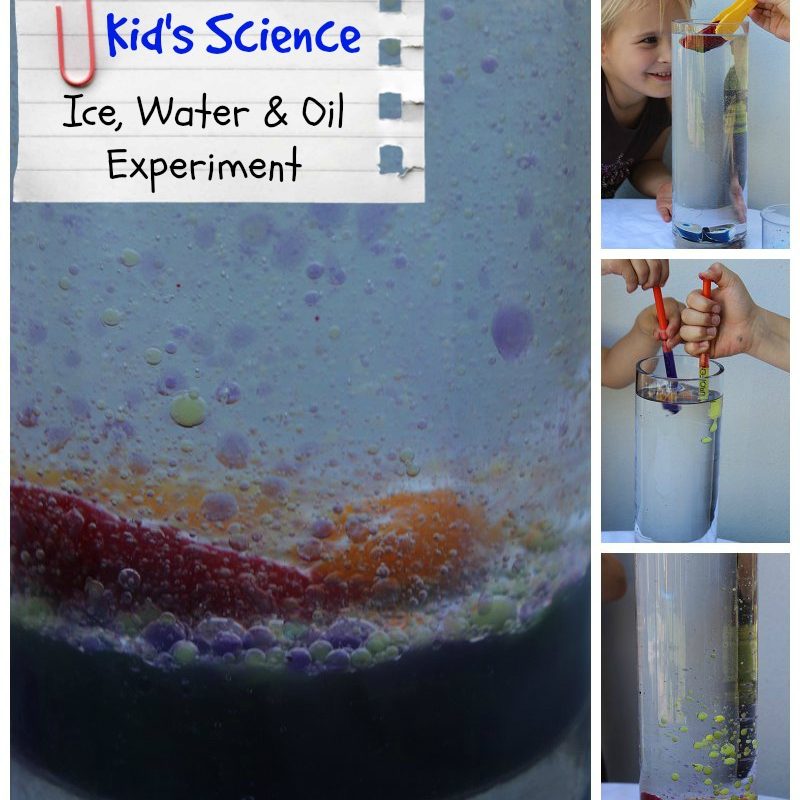
Ice, Oil and Water Experiment
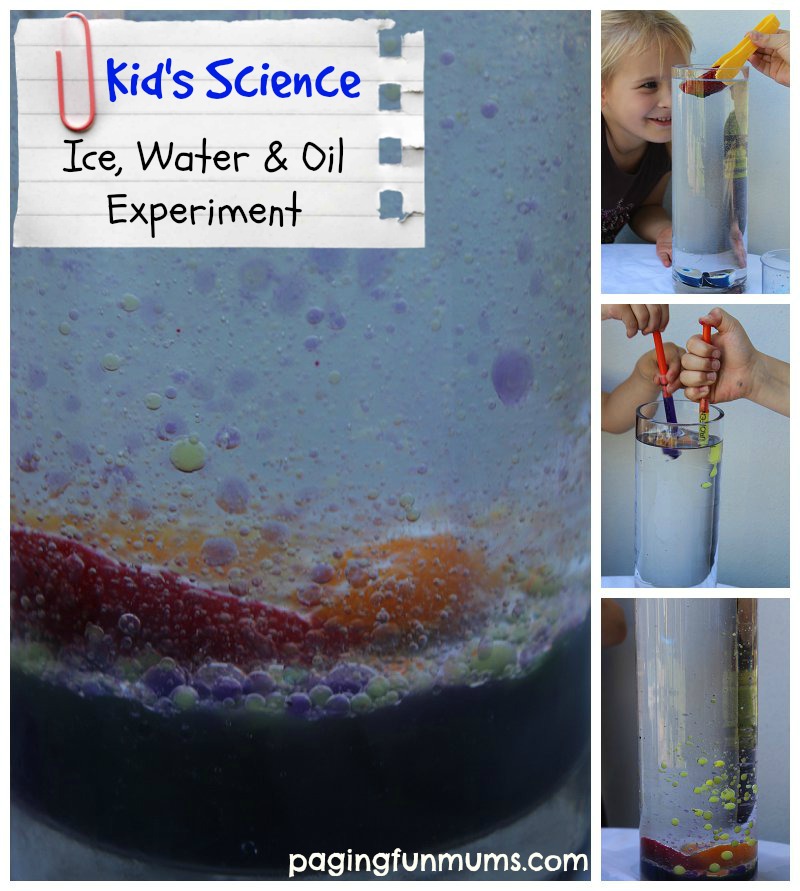
My kids are so interested and amazed with Science, they love learning first hand how things in their environment interact. I also remember loving Science as a child, I vividly remember doing this Ice, Oil and Water Experiment in Science class in grade 7.
Here’s what we used for our home experiment –
- A large glass Vase (you could do a smaller sized regular drinking glass)
- Baby Oil – enough to fill your vase 3/4 full
- Frozen Ice cubes filled with water and food colouring
- empty syringes or dopplers
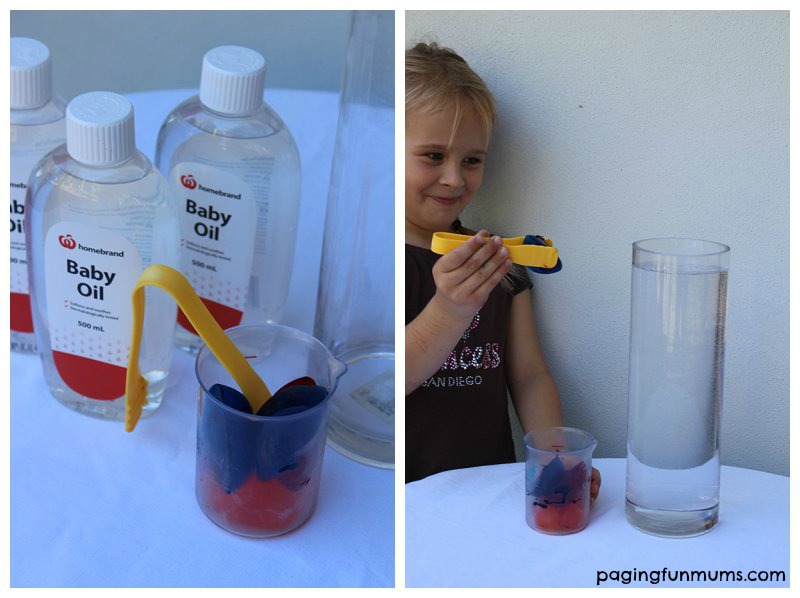
Directions –
Carefully fill your glass vase, have your child hold the ice using the tongs in the oil mixture, then patiently wait and watch…you will slowly start to see a coloured drop of melted water start to bead off the ice and gracefully sink to the bottom.
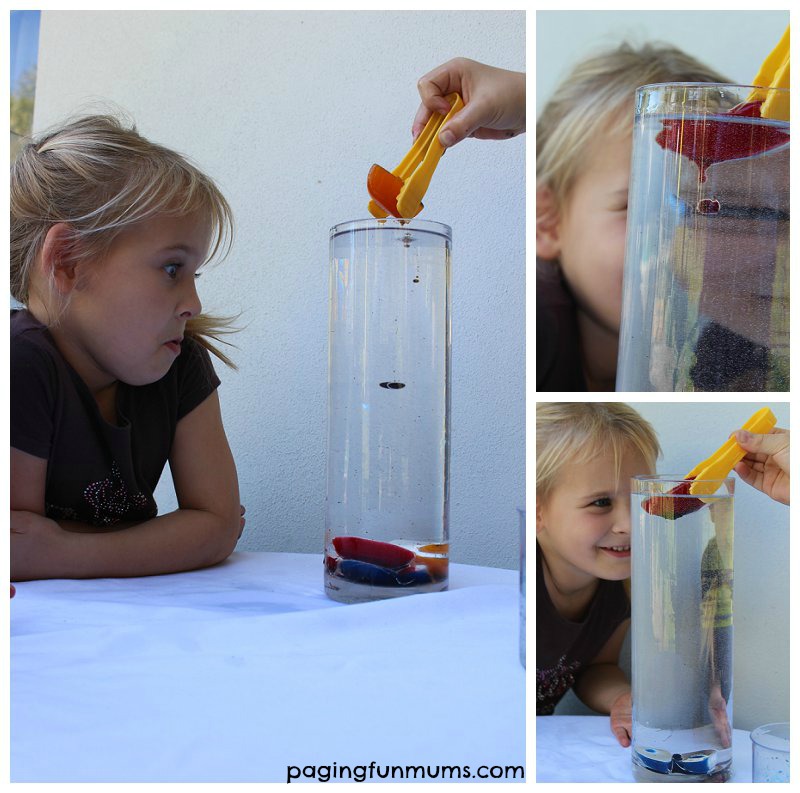
My 5 year old daughter found it hard to keep the slippery ice in the tongs so I grabbed some old medicine syringes, we filled these with coloured water, the kids had a great time squirting the water into the oil.
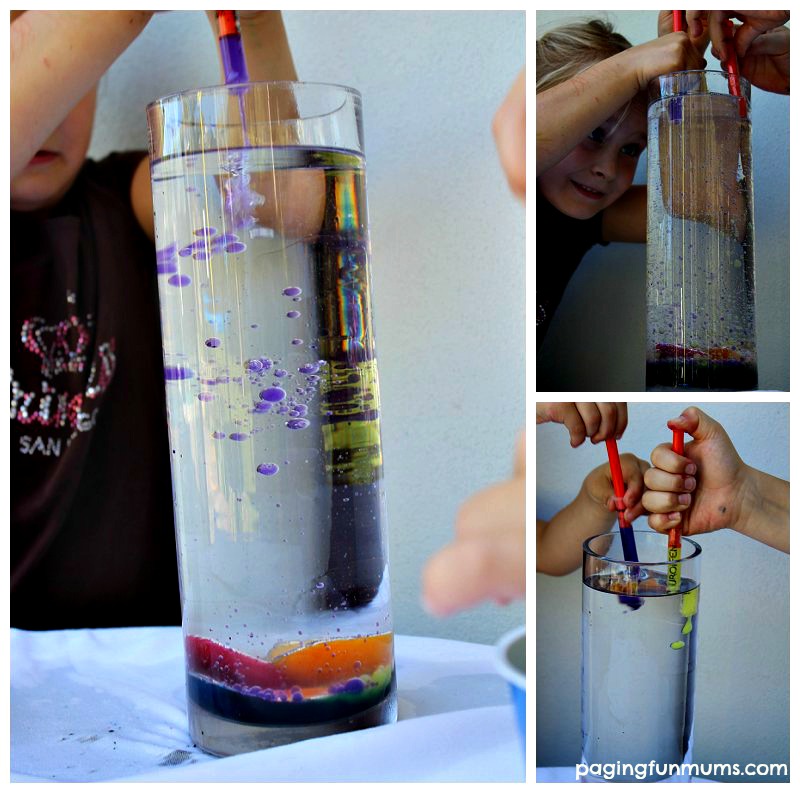
We made a point to write down our observations – What did we see? What happened when the water sat at the bottom of the oil? Why do you think the water made beads and bubbles as it sank to the bottom?
We learned that water and oil do not mix, that oil is less dense than water and therefore it separates with the water remaining in the bottom of the vase. The kids also enjoyed watching the movement of the Oil and Ice once it fully settled to the bottom – my daughter said it reminded her of the ocean and the waves.
We hope you enjoyed the look of this FUN Experiment and choose to try it out at home with your own children.
Here are some other FUN Science Experiments you might also like –
Kid’s Science Fun – Fizzy Experiments
Learn How Plants Absorb Water
DIY Rocket Launcher
Make your own Rock Candy at home!
If you want to become a Fellow Fun Mum Member & receive all of our fun craft, recipes & activities as well as special offers & promotions – click the button on our home page : )

pagingfunmums
You might also like.

Christmas Silly Putty
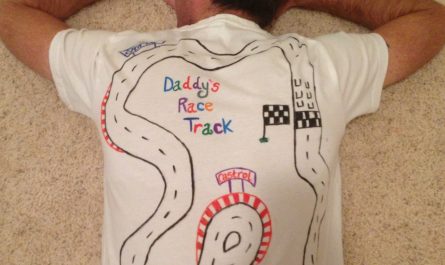

Daddy’s Race Track Tickle Shirt
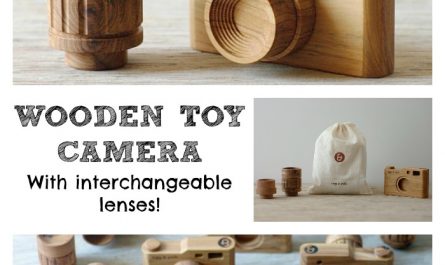
Beautiful Wooden Toy Camera – featured Etsy store!
One thought on “ ice, oil and water experiment ”.
- Pingback: How to Make Magic Aqua Sand
Leave a Reply Cancel reply
Your email address will not be published. Required fields are marked *
Oil and Ice Density Experiment

Introduction: Oil and Ice Density Experiment

Oil and Water. Plaid and Argyle. Hulk Hogan and a movie acting career. Some things just don't mix. In science, we can use these things to experiment with things such as density, buoyancy, and other physical properties. Oil and Water have been played with for a long time, but amazing things happen when you add ice to the mix!
This experiment is a quickie and easy to make, but a great way to increase the complexity of the simple oil and water experiment with young scientists. Take this simple idea, and I'd love to see the different variations you come up with!
- What: Oil and Ice Density Experiment
- Why: Because if Hulk Hogan can get a movie deal, then we can be scientists
- Time: ~an hour for freezing, but 10 minutes to experiment
- Cost: ~$0.25, mostly for oil
- Oil (vegetable works great and is cheap)
- Ice Cube tray + water
- Blue food coloring
- Pipette or Dropper (optional)
Let's mix it up!
Step 1: Make Blue Ice Cubes

If you like clear ice cubes, you're going to love blue ones! These are great to make the melting effects more visible. You'll see soon!
Add a hefty amount of blue food coloring to water in an ice cube tray, and set in the freezer to mix. Let them freeze for a while so they are solid all the way through. You'll find that the color collects toward the bottom of the ice cubes, but that's okay!
Blue ice cubes are useful for lots of experiments, including this other experiment dealing with temperature and density.
Step 2: Add Oil and Cubes

When you're ready for the experiment, add vegetable oil to a cup, and then gently place an ice cube in the top. Do you think the ice cube will float or sink? The answer is: it depends.
To start the discussion, you can ask: what floats when you put oil and water together? What about when you put ice and water? So can we know what will happen when we put ice and oil together? We can't, so we'll have to experiment!
Some ice cubes have a lot air trapped inside of them. Others don't. The ones with air trapped inside will float because air is less dense with oil and works like a lifejacket for the frozen water in the ice cube.
Find an ice cube that floats for the remainder of the experiment.
Step 3: Watch Your Experiment in Action!

The amazing part of this experiment happens as you let the ice cube melt. In water you normally can't watch this process happen, but it's beautiful in oil.
Liquid water begins to collect on the bottom of the ice cube, and as enough accumulates, gravity overtakes adhesive forces and a drop forms. It separates from the oil pulling some liquid water, which snaps back like a rubber band when the drop breaks off.
As the drop falls to the bottom of the jar, it forms into a sphere (the ideal shape for minimizing a surface area to volume ratio). Once it hits the bottom, many drops stay separate due to surface tensions on the oil/water boundary, but after a while, they join together.
It's overall an incredible process to witness all of these physical events together, and takes a while to fully digest. A couple of prompts I ask students include:
- Describe what happens to the ice cube over time
- How often does a water drop form on the ice cube?
- What shape are the drops in?
- What happens to water drops on the bottom of the jar?
- Why does the ice float?
- Why does the liquid water sink?
Step 4: Going Further

You can take this experiment further, and I'm excited to see how you go about it!
A few starting options include:
- Floating Water: Suck up blue water from the bottom of the jar and carefully drip them on the surface. Does the water float or sink? What happens if you poke it? And why?
- Adding Substances: Do the same experiment with some salt added on top of the ice cube? What happens? What about with sand or sugar?
- Temperature: What happens if we warm the oil a bit before the experiment? What happens to the rate of melting? What about if we cool it down in a freezer?
- Other Liquids: What would happen if we tried this experiment in denser solutions? Like honey?
Have fun, and as always, keep exploring!
Let me know your thoughts, comments, or what you come up with below!

Thousands of Families. One Spot.
- Toddler & Preschool
- Tweens to Teens
- Family Health
- Cakes & Baking
- Birthday Parties
- Colouring Pages
- Competitions
- Family Holidays
- Home & Decor
- Product Trials
- Baby and Kids Products
- Classes, Lessons and Activities
- Education and Learning
- Family Activities
- Family Dining
- Family Travel
- Fundraising
- Health Specialists
- Income and Training
- Just for Mums and Dads
- Kids Clothing and Accessories
- Pregnancy and New Parents
- School Holidays
- Toys, Sport and Tech

Science experiment: Freezing oil and water
Mixing oil and water is one thing, but freezing oil and water is fascinating. What will happen and why? Kids love science and love answering all the science questions they can. Get them experimenting in the kitchen.
What you need:
- clear plastic container
Number of players : 1+
Firstly pour some water into the clear plastic container.
Then add the same amount of oil to the container.
Leave this for a few minutes until the oil rises to the top of the container.
This occurs because the oil becomes lighter than the water.
Place the container in the freezer for a couple of hours.
After these couple of hours, you should see that the water is now on top of the oil. Why? Because the water is now a solid. As it expands when is freezes, it also becomes less dense than the oil.
Image from Shutterstock
Share This Story, Choose Your Platform!
Related posts.

Diwali: Festival of lights

Día de muertos

Cricut Unveils Joy Xtra™ & the EasyPress Mini™ in NZ

Must Do School Holiday Experiences

The Garfield Movie: 5 Fun Activity Sheets
Leave a comment cancel reply.
You must be logged in to post a comment.

IMAGES
VIDEO
COMMENTS
Science Experiment - 18 | Freezing Oil and Water Experiment | Easy Chemistry Experiments #ScienceExperiment#Experiment#scienceproject Pebbles Live Channel Fa...
Freezing Oil and Water Experiment | Science Experiment -20 | Easy Chemistry Experiments#ScienceExperiment#Experiment#ScienceprojectOur Channels:Pebbles Tamil...
water is now on top of the oil! Take it further: Repeat the experiment using different types of liquid instead of water (e.g. salt water, milk, vinegar etc). How do these different types of liquid interact with oil when frozen? Try our other freezing experiments: Which freezes first: hot or cold water? and Colourful ice melt. Big questions: Oil ...
The oil and water science experiment is a fantastic way to introduce your child to the wonders of science. By engaging in hands-on activities like this, children develop a deeper understanding of the world around them and nurture their natural curiosity. As parents, we can encourage their scientific exploration by providing them with simple ...
Frozen Ice cubes filled with water and food colouring; tongs; empty syringes or dopplers; Directions - Carefully fill your glass vase, have your child hold the ice using the tongs in the oil mixture, then patiently wait and watch…you will slowly start to see a coloured drop of melted water start to bead off the ice and gracefully sink to ...
This colorful hands-on oil and water experiment is perfect for preschool and kindergarten! Learn basic chemistry while doing this fun science experiment!
About Press Copyright Contact us Creators Advertise Developers Terms Privacy Policy & Safety How YouTube works Test new features NFL Sunday Ticket Press Copyright ...
Oil and Water. Plaid and Argyle. Hulk Hogan and a movie acting career. Some things just don't mix. In science, we can use these things to experiment with things such as density, buoyancy, and other physical properties. Oil and Water have been played with for a long time, but amazing things happen when you add ice to the mix!
Oil and water do not mix. Oil is less dense than water and floats on top of the water. Food coloring is water-based so it mixes with the water. When you add the food coloring to the oil it will not mix. Once you add the oil to the water, the food colored droplets start to drop down since they are heavier than the oil. Once they drop into the ...
water; oil; freezer; Number of players: 1+ Activity: Firstly pour some water into the clear plastic container. Then add the same amount of oil to the container. Leave this for a few minutes until the oil rises to the top of the container. This occurs because the oil becomes lighter than the water. Place the container in the freezer for a couple ...